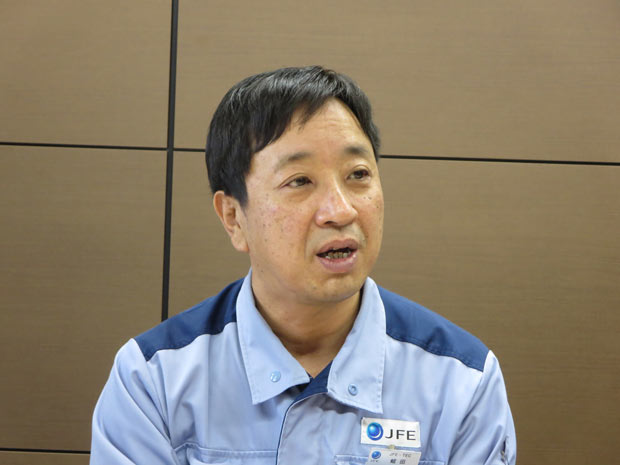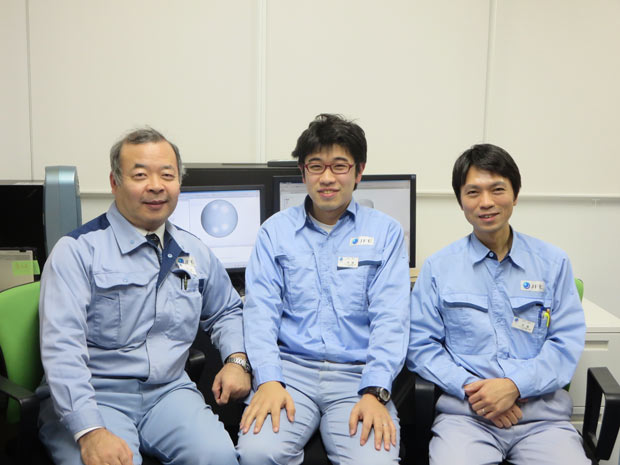
Toshiki Hiruta, director of the CAE Center.
Latest News
January 1, 2016
By Kuninori Masushige & Yuka Takahashi, CD-adapco
JFE Steel Corporation, a long-standing entity in the steel industry for more than 100 years, boasts the world’s fifth-largest scale in terms of its crude steel production. JFE Techno-Research Corporation, a member of the JFE Group, undertakes fluid analysis, structural analysis and other arms of the JFE business, including evaluation, investigation and examination of materials. They cater to steel plants, environmental engineering and other areas within the group, and are also actively contracting for business outside the group. In particular, it undertakes engineering service projects from diverse industry areas including automobile, machinery, electrical machinery, electronic components, construction and civil engineering, research institutions and numerous other sectors. For these areas, they are providing engineering solutions and consulting services based on highly reliable analysis and evaluation technologies.
The strengths of JFE Techno-Research focus on the following two areas:
- The ability to propose solutions not only based on analysis, but also based on experience cultivated over several years in the steel industry,
- The packaging of proposals with testing results: The Solution Division (Kawasaki) comprises of the CAE Center, the Sensing & Visualization Analysis Center, Structure Performance Department, Material Performance Evaluation Department, Equipment & Process Technology Department and other specialized testing and analysis divisions providing a full suite of services.
JFE Techno-Research offers interpretation of analysis results, guidelines for design improvements and consulting related to all aspects of “Monodzukuri” (Japanese-style manufacturing), helping in stabilization of product quality, added functions and reduction of production costs. In this article, CD-adapco talks with members of the CAE Center at JFE Techno-Research about the crucial role of numerical analysis in “Monodzukuri.”
 Joji Kato (center) with Katsuhiro Iwasaki (left) and Norikazu Sato (right) of the CAE Center. Images courtesy of JFE Techno-Research.
Joji Kato (center) with Katsuhiro Iwasaki (left) and Norikazu Sato (right) of the CAE Center. Images courtesy of JFE Techno-Research.Improvements in Calculation Accuracy: Partnering with the Measuring Division for Verification
The single greatest challenge in engineering simulation is the verification of the numerical results. Correlation of numerical analysis with physical testing improves the accuracy of the final results. The target in normal flow analysis at JFE is an accuracy of ±3% when compared to test results. However, for more complex models that include chemical reactions, multiphase flow and other phenomena, the analysis accuracy typically swells to around ±10%.
“While our target is ±3%, with staffers who have built up a certain degree of experience, it becomes reasonably possible to tell whether or not the outcome is appropriate by examining the results,” notes Toshiki Hiruta, director of the CAE Center.
Katsuhiro Iwasaki, senior research engineer, added: “Depending on the customer, in some cases we receive requests for both testing and analysis. This actually presents a rather stiff challenge, and because we come up with test values, there is a need to adjust with the analysis results at the next stage. This is particularly true as the analysis grows more complex, which proportionally raises the importance of interpreting the test values and running comparisons against the analysis results. There are also cases in which our customers present us with test results, asking us for customization based on the models suggested by those results.”
At JFE Techno-Research, the merits of operating measuring divisions are utilized with regard to CFD in taking actual measurements of temperature, flow velocity, gas composition and other parameters. That data is then compared to the CFD (computational fluid dynamics) results to verify its soundness and to further improve the accuracy of the outcome. Figures 2 to 4 show some application areas of simulation at JFE Techno-Research: powder behavior analysis in powder transport piping, cast part fluidity and solidification analysis and hydrogen leak diffusion behavior analysis.
Addressing Diverse CFD Challenges: From Single Phase to Multiphase Flow
For the CFD-related operations at the CAE Center, Iwasaki is in charge of simulations for chemical reactions, combustion, explosions and other thermofluid process issues. In addition to that work, he also engages in support, R&D on his own initiative and other tasks that range from basic research to the creation of actual machinery. Deputy General Manager Norikazu Sato meanwhile serves as the CFD technology staff member primarily devoted to multiphase flow analysis involving thermofluids, heat transfer and particles, and other duties.
“The work here involves various fields but the core of our operations lie in undertaking projects related to structures, fluids and FSI (Fluid-Structure Interaction) analysis. In addition to aforementioned tasks, the CAE Center is also active in the development of analysis methods for application in new fields. In fluid analysis as well, for example, R&D is being advanced not only on a single phenomenon basis, but also geared to more complex phenomena known as multiphysics. While the company includes a division that develops its own numerical simulation code, it also utilizes commercial CFD software to expand the fields of adaptation,” says Hiruta. JFE Techno-Research and CD-adapco are collaborating in building of models to support such R&D efforts.
The Importance of Interpretation & Evaluation of Analysis Results
Sato explains the system used to implement the actual analysis operations: “Our center has acquired certification under ISO 9001 as our Quality Management System (QMS). In performing analysis, we assign project managers to each engineering service project, effectively deploying a check system to ensure that the analysis is conducted correctly and in keeping with the specs. In most cases, the standard approach is for one technical staff member to serve as the project manager, with one or two younger team members performing the actual analysis. While it is the young staffers who work with the CFD code to advance the work, depending on the specific analysis, there are also cases when senior engineers step in to operate the analysis software, perform customization, test calculations and other tasks.”
Next, we inquired about the key points of care when undertaking analysis as a team, means of sharing information between the company’s various departments/locations and other relevant challenges. Iwasaki explains the methods of communication: “We devote particularly keen attention to maintaining close connections in our reporting, liaison and consultations, as well as preserving confidentiality. It is desirable, meanwhile, that On-the-Job Training (OJT) for our younger team members be effective in simultaneously raising their potential and passing on the company’s technology. Without effective reciprocal communication, we run the risk of moving in different directions and perpetrating irreparable mistakes.”
He adds: “When implementing analysis on the foundation of stipulated conditions or assumptions, we also hypothesize questions likely to be voiced by the customer regarding the viability of the results and advance the work while sharing ideas with our young team members. In the area of model building, I sense a vital need to engage in close reciprocal communication with our younger people in working to determine if our results appropriately reflect the technical concepts of the analysis targets, how to evaluate the analysis results, how to explain the outcome to customers. In particular, due to the fact that it usually proves unfeasible to fully simulate the actual physical phenomena, chemical reaction processes or other conditions with CFD, we devote special care to the methods of hypothesis and projection, as well as to the interpretation and evaluation of the results of our analysis. To our young members, I set aside particular time and attention to stress the importance of grasping what the customer wants to learn, what they truly have in mind and other key concerns.”
STAR-CCM+ Offers High Hopes for Expandability Above & Beyond CFD
At JFE Techno-Research, STAR-CCM+ has received stellar evaluations on two key points. First, the integrated workflow, which spans geometry preparation, meshing, physical modeling, analysis and post-processing, is considered extremely user-friendly. Secondly, the multidisciplinary software package provides linear stress analysis options both within the code and through coupling to Abaqus and other stress solvers, facilitating its use in evaluations of material selection. Looking ahead, there are also high hopes that the addition of FEM functions from v10.04 onwards will further expand the FSI analysis domain.
According to Sato, STAR-CCM+ has earned solid accolades in terms of its meshing function — notably, the ability to create a mesh with simple operations even when working with rather complex geometries. He says that this is the key to swift analysis of prototypes. Sato also praised STAR-CCM+ for being able to readily link up multiple physical models, easy customization via field functions and scripting, and other advantages.
Finally, we asked about the enhancements that they would like to see introduced in STAR-CCM+ and services requested to CD-adapco. Iwasaki is conducting studies and evaluations on the streamlining of a simplified manufacturing process simulation independently with STAR-CCM+. He wants to output the cooling speed with solidification analysis, distribution of secondary phase in dispersion strengthened material, and let them reflected in material properties. Iwasaki believes that if the fruits of these efforts can be channeled back to STAR-CCM+ for performing linear stress analysis finding stress concentration area, it should be possible to realize more efficient shapes and processes.
Sato is advancing work on analysis proposals and engineering services in the areas of DEM, FSI, large-scale computing and optimization. With STAR-CCM+ offering a high level of customization, he believes it will be possible to propose complex analysis techniques at a truly unprecedented level. Hiruta also mentioned potential applications in healthcare-related fields – with particularly keen efforts currently being channeled into the implant structure analysis realm. He also admits that while fluid analysis in life sciences remains a largely unknown domain, it is nevertheless a challenging area for growth.
Conclusion
The CAE Center in JFE Techno-Research is undertaking a considerable number of projects outside of the JFE Group. The reports of how their CAE experiences, built up in the iron industry, are being put to use in other fields were truly inspiring. Hereafter, in addition to the CFD analyses, they will deal with the FSI analysis and new fields such as healthcare. CD-adapco certainly stands ready to mobilize the full span of its global resources in doing everything possible to support their efforts.
More Info
Subscribe to our FREE magazine, FREE email newsletters or both!
Latest News







